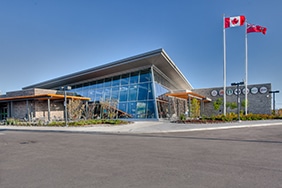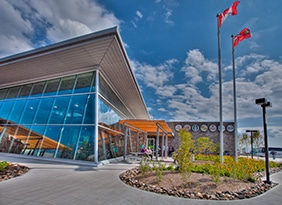LEED Spotlight January: Ontario’s ONroute Service Centres
Mallorytown, Ontario
January 11, 2013
- Rating System/Standard
- LEED v1
- Certification Level
- Silver
- Building Type
- Other
Read about the LEED certification of 20 ONroute Service Centres on Ontario highways.
There are 20 ONroute Service Centres on Ontario highways – identifiable and welcome landmarks for travelers looking to take a break from their often long journeys across the province. Many of you may have noticed that the Centres recently became LEED certified, with a goal to pursue LEED certification for all of the buildings upon completion of construction.
We spoke to Michael Jones, HMSHost Vice President of Business Development, about the features of these buildings, the way they approached building LEED on such a large scale, and why LEED certification was a key component of their plan from the beginning.
Tell me a little bit about the project(s) and the unique features, particularly those that led to it certifying LEED Gold.
Host Kilmer Service Centers, the joint venture partnership between global restaurateur HMSHost and Kilmer Van Nostrand Co. Limited operate the ONroute Service Centres along Ontario’s Highways 400 and 401. Since the beginning of this project in 2009, building and operating as sustainably as possible has been a primary focus. This is why Host Kilmer chose Quadrangle Architects Limited, one of Canada’s most dynamic architectural firms, to design the ONroute Centres.
Today, 19 of 20 centres have completed construction and are operational, with 14 LEED certifications achieved thus far. The organization has set the goal to eventually achieve LEED certification at all 20 Service Centres. To date, four ONroute Service Centres have achieved LEED Gold and 10 have achieved LEED Silver. Certifications were made possible by collaborative efforts between Host Kilmer and the Province of Ontario.

The ONroute Service Centres were designed to be architectural reflections of Canada’s most famous city structures and Ontario’s rocky natural landscapes. To achieve this, common elements and built-in sustainable attributes can be found throughout all of the centres that were incorporated to ensure an easily identifiable appearance and operational longevity for public use. The designs for the centres incorporate three distinct elements: a glass atrium with sloped glass walls covered by a sloped metal roof; traditional indigenous stone walls; and wood trellises and canopies.
Typical LEED measures applied to the project include:
- High efficiency HVAC equipment with heat recovery to minimize energy consumption.
- Demand control (CO2) ventilation to minimize energy use and maximize indoor air quality.
- Highly efficient lighting (compact fluorescents and LED exit signs) to reduce electricity consumption and minimize internal heat gain.
- High albedo (reflective) roof membrane to minimize external heat island effect.
- Strategic use of glazing (curtainwall and skylights) to allow for daylight throughout the building – including back of house areas.
- Use of regional and recycled construction products to reduce demand on virgin materials.
- Use of FSC certified wood products obtained from responsibly managed forests.
- Use of native and hardy plant species to reduce (virtually eliminate) the need for irrigation and fertilizers.
- Purchase of Renewable Energy Certificates (“Green Power”) to support the continued development of renewable energy sources such as solar and wind.
- Use of low flow plumbing fixtures to minimize the consumption of potable water.
Some project metrics that reflect the environmental impact that has already been achieved:
- Total of 24,476 metric tonnes of construction and demolition waste diverted from landfill.
- Total of 18,769,341 MJ’s (Megajoule, MJ) or 18,769 GJ’s (Gigajoule, GJ) of energy saved per year (Note: average home consumes about 106 GJ per year).
- Total of 722,323,173 litres (722,323 m3) of potable water saved.
Why do you think LEED certification was better for your project than a less rigorous form of green standard?
The green standards and building codes set forth by LEED and the CaGBC are the benchmark of the entire industry regarding sustainability. LEED certifications represent the most comprehensive set of criteria for credibly measuring and gauging sustainable building practices. These standards are extremely useful during the design and construction phase of building projects, as well as after the public opening.
Hence, choosing LEED certification standards was the obvious and appropriate building code choice. The standards that LEED has established gave the entire ONroute system a framework from which to approach design questions and building issues in a way that is proven to benefit all who are involved. Achieving LEED certifications at ONroute Service Centres also directly aligns with the goals set forth by HMSHost’s start somewhere® sustainability initiative, which aims to make the world a better place by reducing environmental impact. Within the startsomewhere initiative, one of three major focuses is The Environment.
Emphasized under this focus are three major areas that HMSHost feels are important to reducing environmental impact:
- Diverting waste from landfills, through reducing, recycle and repurposed materials.
- Conserving the use of electricity and water, through reducing consumption.
- Using materials that are better for the environment, both in construction of our properties, and in the products we use.
With these in mind, it is apparent that the cumulative credits that warrant a LEED certification also aid the broader organization with its own internal sustainability goals.
What value does LEED certification bring to your buildings, both as an owner and/or property manager and for those the tenants who occupy it?
Most notably, LEED certifications for the ONroute Service Centres along the 400/401 corridors bring value to the project in terms of the impact being made on regular visitors. LEED has become widely known and respected by society and having the ability to display LEED certification makes an impactful statement to everyone who travels the ONroute motorways. Aside from the obvious environmental benefits and social responsibility, these achievements let visitors know that they are supporting responsible construction. This translates into a badge of honor for Host Kilmer, but it also symbolizes an important step forward in what the general public expects from the building community – it raises the bar, and that is something that benefits us all.
More specifically, ONroute serves as an example of how a public/private partnership can effectively collaborate to achieve significant progress in green building for publicly used spaces. ONroute Service Centres are facilities that the entire region can be gratified and proud to have as a usable resource for many years to come. All of the certifications serve as a symbol of leadership in sustainable development for travelers to see, but the four Service Centres that have achieved LEED Gold certification are an especially noteworthy source of pride for the group who worked on the ONroute project.
Overall, great value has been gained for Host Kilmer in the form of verifying our integrity as a responsible developer and public partner, as well as by solidifying our role as a caring member of the local community; all of which was made possible by way of LEED standards.
What was the biggest lesson learned from building a LEED project that you think would be valuable to other building LEED?
Having a clearly defined LEED mandate/strategy at the outset of the project is of the utmost importance. With the scope of the project in mind, achieving LEED certifications for each plaza was and still is quite a formidable one. The objectives set forth by the project require a steadfast commitment in order to reach the desired outcome of LEED certification. During the building phases of the project, the team learned that paying careful attention to all aspects which contribute to LEED credits is paramount to timely certification. This will also be important as the project continues to develop with the remaining ONroute Service Centres.

Hiring a team with a proven track-record of success in the execution of LEED projects, in terms of design, construction, and certification is another major takeaway. Today, the project is advancing smoothly towards the goal of all 20 plazas achieving LEED certification. This progress could not have been made without the great partners that have assisted Host Kilmer along the way. Ellis Don Construction, Quadrangle Architects, and the Province of Ontario were extremely instrumental in reaching these milestones for ONroute Service Centres. Without this intricate collaboration, the project would not have been as successful as it has been. However, with complex partnering, challenges also arise.
Dedicating the appropriate time, resources and staff to the LEED initiative is a key to ensuring success. Managing time and successfully collaborating with many partners for the proper implementation of the standards needed for LEED credits was a challenge that required constant attention. Success is ultimately defined by sticking to these principles and applying them during all steps of the building and certification process. For Host Kilmer, working as a team and making necessary adjustments along the way enabled the group to achieve the goals of the project.